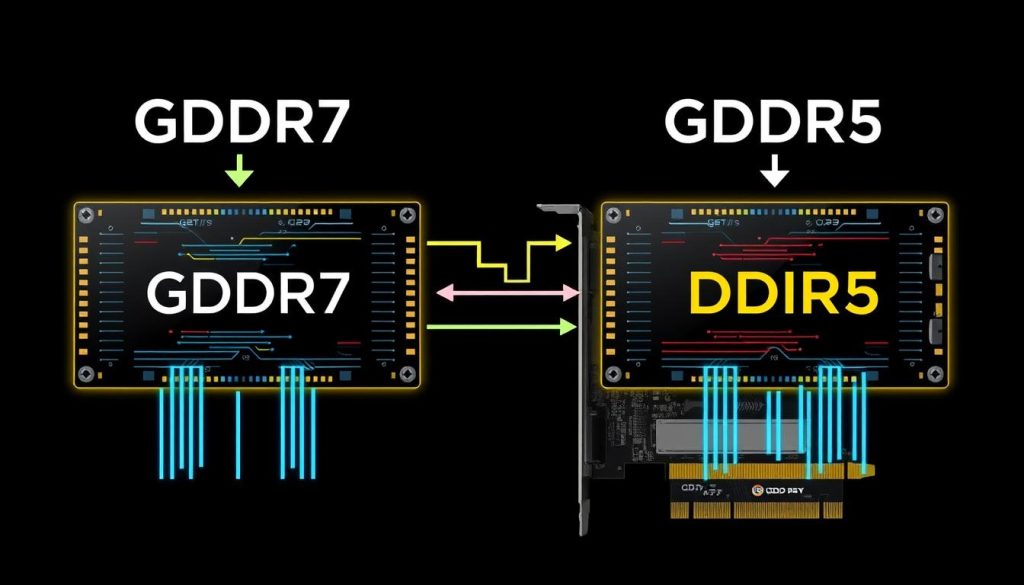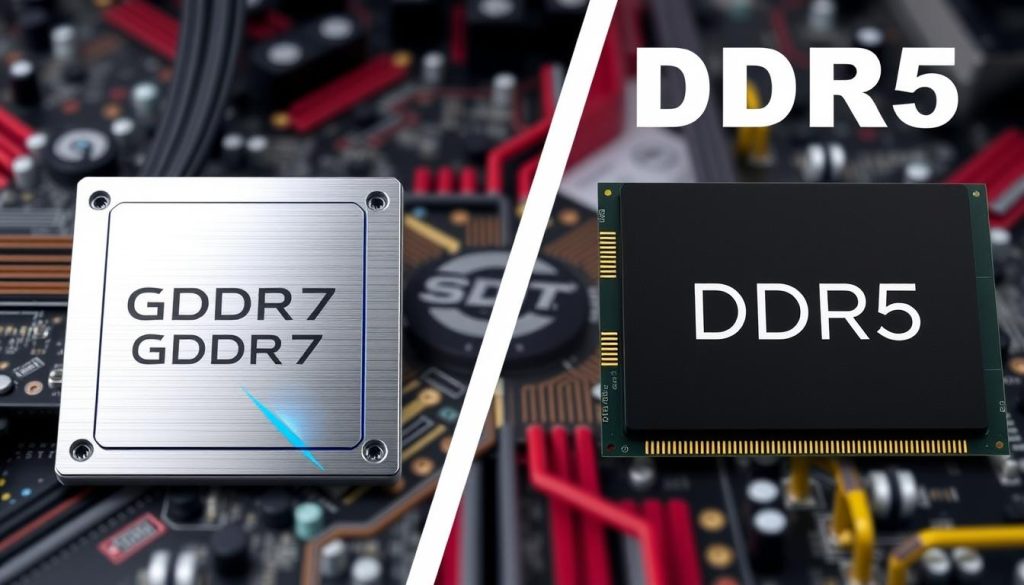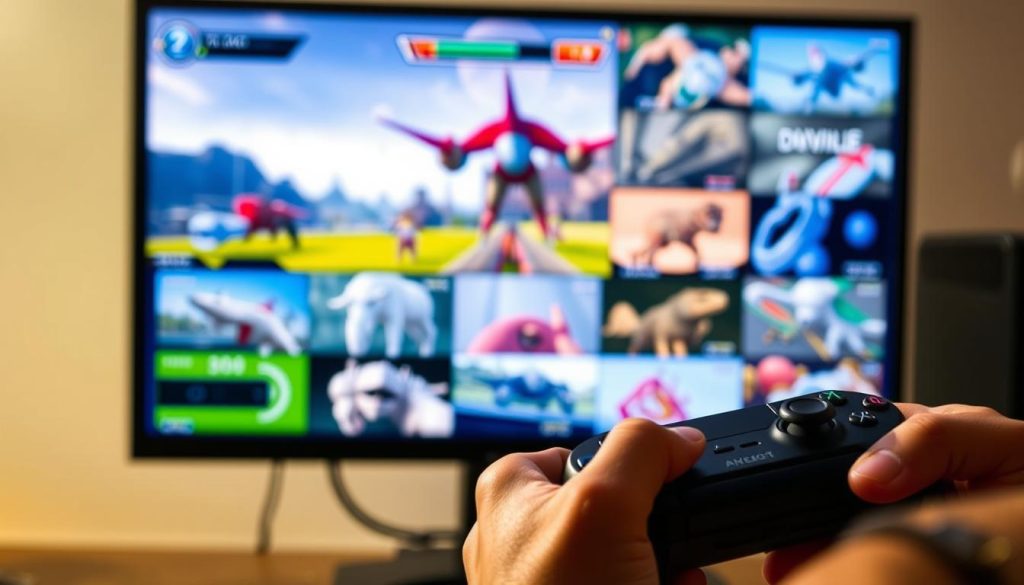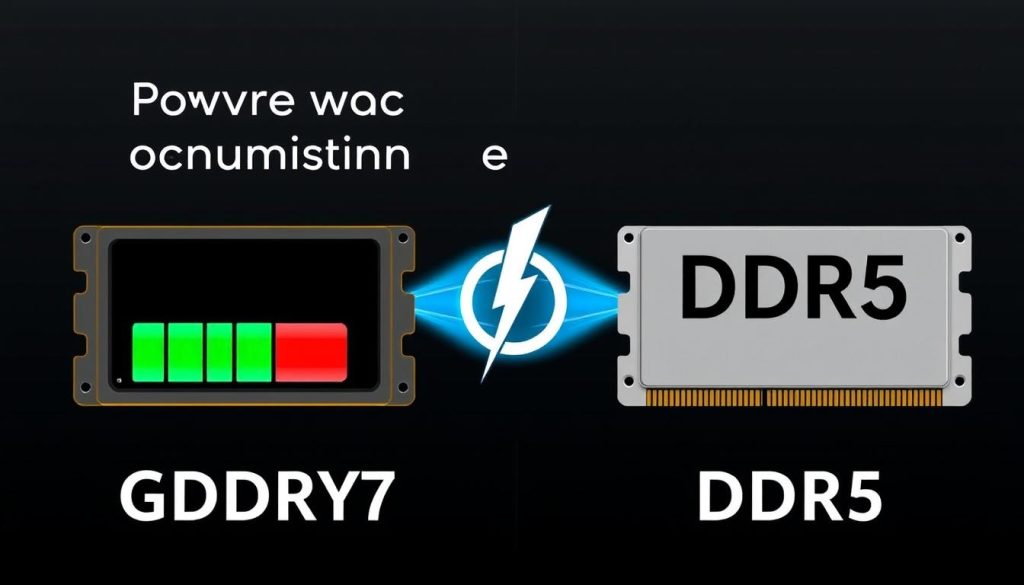
GDDR7 vs DDR5: Key Differences Explained
The computing world is moving fast towards more immersive gaming and high-resolution displays. This has sparked a race for the next-generation memory standard. GDDR7 and DDR5 are at the center of this race. They are key to handling graphics-heavy tasks and ensuring smooth performance.
In this detailed article, we’ll explore the main differences between GDDR7 and DDR5. We’ll look at how they affect graphics performance, memory bandwidth, and their role in the future of gaming and content creation. Knowing the strengths and weaknesses of these advanced memory solutions helps us make better choices for our tech needs.

Show two computer chips side by side, one labeled GDDR7 and the other labeled DDR5. Use different colors and patterns to distinguish between the two. Show them both connected to a motherboard or graphics card, with data flowing between them. Add some arrows or motion lines to indicate the direction of data transfer. Make sure to show GDDR7 as the newer and faster technology, perhaps by depicting it as larger or more powerful-looking.
Key Takeaways
- GDDR7 and DDR5 are the next-generation memory technologies that will power the future of graphics and system performance.
- GDDR7 is designed specifically for graphics applications, offering significantly higher data transfer rates and memory bandwidth compared to DDR5.
- DDR5 is the latest iteration of the widely-adopted system memory standard, boasting improved energy efficiency and increased capacity.
- The choice between GDDR7 and DDR5 will depend on the specific needs of the application, with GDDR7 being more suitable for gaming and content creation, and DDR5 better suited for general-purpose computing.
- Understanding the key differences between these memory technologies is crucial for making informed decisions about future hardware upgrades and investments.
Understanding Graphics Memory Technologies
Modern graphics cards rely on their memory technologies for top performance. Memory bandwidth is key to how fast data moves between the GPU and video memory (VRAM). It has grown a lot to meet the needs of gaming and making content.
Memory Bandwidth and its Impact on GPU Performance
Memory bandwidth, in gigabytes per second (GB/s), shows how fast data moves between the GPU and VRAM. A higher rate means the GPU can handle more data, leading to better graphics and smoother games. As games and graphics tasks get more complex, having enough memory bandwidth is vital for great gpu performance.
Evolution of Memory Standards for Graphics Cards
The memory technologies in graphics cards have changed a lot to keep up with industry needs. From old SDRAM and GDDR to newer GDDR6 and GDDR7, each update has brought big leaps in memory bandwidth, video memory size, and gpu architecture efficiency.
- SDRAM (Synchronous Dynamic Random Access Memory) – Provided basic memory support for early graphics cards.
- GDDR (Graphics Double Data Rate) – Introduced in the early 2000s, offering higher data transfer rates compared to SDRAM.
- GDDR6 – The current industry standard, delivering exceptional memory bandwidth and performance for modern gaming and content creation.
- GDDR7 – The upcoming next-generation memory standard for graphics cards, promising even greater memory bandwidth and advancements in graphics memory technologies.
The growth of memory standards for graphics cards has boosted gpu performance over time. This has led to more realistic games and more powerful tools for making content.https://www.youtube.com/embed/pbgvzVgfoSc
GDDR7 vs DDR5: The Next-Gen Memory Battle
The graphics memory world is seeing a big fight between GDDR7 and DDR5. These two technologies are set to change the game in gaming and high-performance computing. It’s important to know how they differ.
GDDR7 is the newest type of Graphic Double Data Rate memory. It’s all about fast data transfer rates. This means better gaming and smoother content creation. DDR5, on the other hand, is the next big thing in system memory. It makes computers run faster and use less power.
| Feature | GDDR7 | DDR5 |
|---|---|---|
| Memory Bandwidth | Up to 1 TB/s | Up to 128 GB/s |
| Memory Bus Width | 256-bit to 384-bit | 64-bit to 128-bit |
| Power Efficiency | Optimized for lower power consumption | Improved energy efficiency compared to DDR4 |
| Latency | Slightly higher than DDR5 | Lower latency than GDDR7 |
The fight between GDDR7 and DDR5 will decide the future of gaming and making content. As gddr7 vs ddr5 heats up, everyone is watching for what these new memory technologies will do for graphics memory and video ram comparison.

Two computer chips face each other, one labeled GDDR7 and the other labeled DDR5, with a line drawn between them indicating competition. The GDDR7 chip appears sleek and futuristic, with a metallic finish and glowing blue accents. The DDR5 chip looks more traditional, with a matte black finish and simple design. The background is a blurred mix of circuits and wires to convey a high-tech environment.
An unexpected error occurred while regenerating the image. Please try again.
The choice between GDDR7 and DDR5 will greatly affect the performance of the next-generation nvidia vs amd memory solutions.
GDDR7: Unleashing Unparalleled Graphics Performance
GDDR7 is the newest step in graphics memory technology. It’s set to change the game for gamers and creators. This tech brings huge boosts in data transfer rates and memory bandwidth. This means better graphics performance for today’s high-resolution screens and immersive games.
Higher Data Transfer Rates for Smoother Gaming
GDDR7 has amazing data transfer rates, way better than before. It can move huge amounts of data smoothly. This means no lag in even the most demanding games, making gaming smoother and more fun.
Increased Memory Bandwidth for High-Resolution Displays
GDDR7 also has a big boost in memory bandwidth. This lets gpu memory handle high-resolution displays easily. You get sharp visuals and engaging experiences for gamers and creators alike. The vram capacity and speed of GDDR7 help even complex gpu architecture perform at its best.
With GDDR7 on the horizon, the future of graphics and gaming looks very bright.

Create an image of a computer screen displaying a high-resolution, graphically-intensive game running smoothly with GDDR7 memory. The colors are vibrant and the details are crisp, showcasing the unmatched performance of GDDR7 technology. In the foreground, a controller is held with intense focus as the player immerses themselves in the stunning visuals and smooth gameplay. In the background, various images of complex 3D models and animations demonstrate the fluidity and precision of GDDR7 graphics rendering.
DDR5: Revolutionizing System Memory
The technology world is always changing, and DDR5 is bringing big changes to how we use computers. DDR5 is the newest type of system memory. It’s making computers faster and more efficient.
DDR5 is a big step up from DDR4. It has more memory bandwidth and data transfer rates. This means it will make GPU performance and overall system speed better. It’s great for heavy gaming and creating content.
| Specification | DDR4 | DDR5 |
|---|---|---|
| Memory Bandwidth | Up to 3,200 MT/s | Up to 6,400 MT/s |
| Memory Density | Up to 16 GB per module | Up to 64 GB per module |
| Power Consumption | 1.2V | 1.1V |
DDR5 isn’t just about speed. It uses less power and is more energy efficient. This means it’s better for the planet and our wallets.
“DDR5 is poised to set a new standard for system memory, unlocking unprecedented levels of performance and efficiency for a wide range of computing applications.”
As we move to this next-generation memory standard, the changes will be huge. DDR5’s better specs and energy use will change how we use our devices. It’s starting a new era of smooth, fast computing.

Create an image of a futuristic motherboard with DDR5 memory modules installed, glowing with a vibrant blue light. Make the memory modules appear sleek and streamlined, with intricate circuitry visible through a transparent casing. The motherboard itself should be highly detailed, with metallic accents and intricate patterns etched into the surface. Surround the motherboard with futuristic technology and digital circuitry to emphasize its cutting-edge nature.
Power Consumption: A Crucial Factor
Our world is getting more digital by the day, making us worry about how much power our devices use. This worry is big in graphics memory, where we need high performance but also want to save energy. New memory tech like GDDR7 and DDR5 are stepping up to the plate.
Energy Efficiency in Next-Gen Memory Technologies
The next big thing in memory tech is making things work better without using more power. GDDR7 is a great example. It’s made to save power and still deliver top-notch graphics performance and gaming performance.
- GDDR7 memory chips work at lower voltages, which means they use less power.
- It has smart power management that adjusts power use based on what the task needs.
- This next-gen memory tech also keeps things cool, which helps it perform better.
DDR5 memory is all about being more efficient with power too. It’s better at controlling power and using it wisely, which helps cut down on overall power use.

Create an image that visually represents the difference in power consumption between GDDR7 and DDR5 memory. Use contrasting colors or symbols to show the varying levels of energy usage. Incorporate elements such as a battery icon or power meter to convey the concept of power consumption. The image should be clear and easy to understand without any accompanying text.
“The quest for energy-efficient memory technology is crucial in the age of high-performance computing and gaming, where power consumption directly impacts system performance, cooling requirements, and environmental sustainability.”
As we aim for better graphics performance and gaming performance, keeping an eye on power consumption and energy efficiency will be key. This will help shape the future of memory technologies.
Memory Latency and its Implications
In the world of graphics and gaming, memory latency is key to how fast and efficient a system works. While we often talk about memory bandwidth, memory latency is also very important.
Memory latency is how long it takes for memory to answer a request from the graphics or central processing units. This delay affects how well graphics-heavy apps and games run.
| Memory Technology | Typical Memory Latency |
|---|---|
| GDDR6 | 16-20 ns |
| DDR5 | 12-16 ns |
| GDDR7 | 10-14 ns |
The latest memory tech, like GDDR7, has much lower latency than older ones. This means better graphics performance and gaming performance. It also makes the system more responsive.
For GPU architecture and memory technology that need fast data access, low latency is key. This includes real-time rendering, ray tracing, and other advanced graphics. Faster data access in video memory or VRAM means better performance and efficiency.
“Optimizing memory latency is a key priority for graphics hardware manufacturers as they strive to deliver the best possible user experience for gamers and content creators.”
Compatibility and Adoption of New Memory Standards
The introduction of new memory technologies like GDDR7 and DDR5 brings both chances and challenges. It’s key to make sure these memory standards work well together. This is important for better graphics and gaming experiences.
GPU Architecture Considerations
For new memory standards to work well, the GPU architecture must be right. Designers need to make sure their graphics cards can use the new memory fully. This means making sure memory controllers and other parts work well together.
Not all GPUs will work with the new memory right away. Companies must spend a lot on research and testing. This ensures that new memory works well with GPUs, making it ready for use by everyone.
| Memory Standard | Bus Width | Data Transfer Rate | Memory Bandwidth |
|---|---|---|---|
| GDDR7 | 256-bit | Up to 24 Gbps | Up to 768 GB/s |
| DDR5 | 128-bit | Up to 6.4 Gbps | Up to 51.2 GB/s |
The table shows how GDDR7 and DDR5 differ in key specs. This highlights why the right GPU architecture is crucial for good performance and compatibility.
As the tech world moves to these new memory technologies, making them work well with GPUs is key. This will help make sure they are widely used and improve gaming and other tasks.
The Impact on Gaming and Content Creation
New memory technologies like GDDR7 and DDR5 are changing the game for gamers and content creators. They bring big improvements in memory speed, data transfer, and how much data the GPU can handle. This means better performance for tough tasks.
Performance Gains for Demanding Workloads
Gamers and creators will see a big jump in their work. The faster memory bandwidth and data transfer rates of GDDR7 and DDR5 mean better gaming performance and graphics performance. This lets them handle high-resolution displays and complex tasks smoothly.
- More gpu memory and vram means better asset management and higher-quality textures. This leads to amazing gaming visuals.
- Better memory bandwidth means quicker data processing. This cuts down on lag and makes frame rates smoother, especially in tough gaming performance situations.
- Creators will work faster with quicker data transfer rates and more memory bandwidth. This means quicker rendering and more efficient content creation workflows.
These new memory technologies are pushing the limits of what’s possible in gaming and content creation. They’re opening up new levels of performance and creativity.
Future Roadmaps: What Lies Ahead?
Looking ahead, next-gen memory technologies like GDDR7 and DDR5 are set to change the game in graphics, computing, and gaming. These new memory solutions will push performance limits, bringing us into a new era of better GPU performance and gaming.
One big focus is on making data transfer rates and memory bandwidth faster. Experts think GDDR7 could hit speeds of up to 36 Gbps, a big jump from GDDR6. This means smoother, more detailed visuals in games and content, making everything more immersive.
| Memory Technology | Potential Data Transfer Rates | Power Consumption Improvements |
|---|---|---|
| GDDR7 | Up to 36 Gbps | 15-20% reduction in power consumption compared to GDDR6 |
| DDR5 | Up to 8 Gbps | 20-25% reduction in power consumption compared to DDR4 |
These new memory technologies are also getting better at using less power. GDDR7 and DDR5 could use 15-20% to 20-25% less power than before. This is good news for the environment and for keeping devices running cool and quiet.
As we move forward, making sure these new memories work well together is key. GPUs and systems will need to adapt to use these new memories fully. This ensures they work well in many devices and apps.
The future of next-gen memory is exciting, promising to improve graphics, gaming, and computing. We’re looking forward to seeing how these changes will shape our digital world.
Conclusion
The fight between GDDR7 and DDR5 is heating up, showing us a big leap in graphics memory technology. GDDR7 is set to bring top-notch performance with faster data transfer rates and more memory bandwidth. This is great for modern gaming and high-resolution displays.
On the other hand, DDR5 is changing the game with better energy efficiency and faster speeds. Both technologies have their own strengths, showing how the memory industry is always pushing forward. They aim to meet the changing needs of users.
Choosing between GDDR7 and DDR5 will depend on what you need, like gaming, making content, or everyday computing. As graphics and system memory keep getting better, we’re sure to see these advanced technologies work together. They will shape the future with immersive experiences and top performance.
FAQ
What is the difference between GDDR7 and DDR5 memory technologies?
GDDR7 is a new type of graphics memory for high-performance graphics cards. It has much faster data transfer rates than DDR5, which is for general computing. GDDR7 is made for graphics work, while DDR5 is for everyday computer tasks.
How does memory bandwidth impact GPU performance?
Memory bandwidth is key to how fast a GPU works. A higher bandwidth means the GPU can handle more data, making graphics smoother in games and videos. GDDR7 and DDR5 aim to boost memory bandwidth for better performance in demanding tasks.
What are the key advantages of GDDR7 over DDR5 for gaming and content creation?
GDDR7 beats DDR5 for gaming and making content. It has faster data transfer rates, making games run smoother and look better. This means better graphics and a more fun gaming experience. For making videos and 3D models, GDDR7 speeds up the process.
How do GDDR7 and DDR5 memory technologies differ in terms of power consumption and efficiency?
Both GDDR7 and DDR5 focus on using less power and being more efficient. GDDR7 uses less voltage and DDR5 saves energy with new features. They aim to balance performance with power use for graphics tasks and eco-friendly computing.
What are the challenges associated with the adoption of GDDR7 and DDR5 memory standards?
New memory standards like GDDR7 and DDR5 bring challenges. They must work well with current systems and be made in large quantities. Working together, memory makers, GPU companies, and system builders can make the switch smoother.
How will GDDR7 and DDR5 impact the future of gaming and high-resolution displays?
GDDR7 and DDR5 will change gaming and high-resolution displays a lot. They let GPUs handle high-quality graphics and smooth frame rates in games. This means more immersive games and better video editing and 3D work.
No Comments